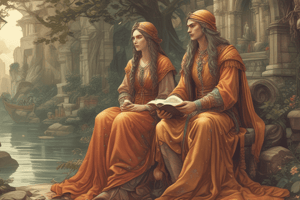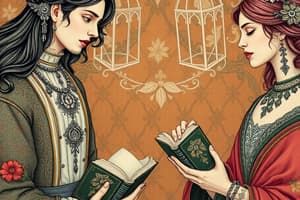Podcast
Questions and Answers
Define a protagonist and explain their role within a narrative.
Define a protagonist and explain their role within a narrative.
A protagonist is the central character who exhibits a good personality and faces conflicts that drive the plot towards resolution.
Identify and describe the role of antagonists in a story.
Identify and describe the role of antagonists in a story.
Antagonists are characters or forces that create conflict for the protagonist, representing obstacles that must be overcome.
What distinguishes flat characters from round characters in literature?
What distinguishes flat characters from round characters in literature?
Flat characters are static and exhibit one distinct personality trait without significant change, while round characters develop and evolve throughout the story.
What theme can be inferred from the story 'A Boy Who Cried Wolf'?
What theme can be inferred from the story 'A Boy Who Cried Wolf'?
What are symbolic characters in literature, and how do they function?
What are symbolic characters in literature, and how do they function?
Describe the climax in a typical story structure.
Describe the climax in a typical story structure.
Explain the significance of theme in a narrative.
Explain the significance of theme in a narrative.
Explain how a chronological plot is structured.
Explain how a chronological plot is structured.
What impact does the point of view have on a story?
What impact does the point of view have on a story?
In what way does 'out of sequence' plot development enhance storytelling?
In what way does 'out of sequence' plot development enhance storytelling?
Flashcards are hidden until you start studying
Study Notes
Characters
- Characters bring the human aspect to literature; they can be human, animals, objects, places, or events.
- Dialogue exchanges and character development build their stature throughout the story.
General Classifications
- Protagonist: Central character facing conflict, representing good personality, and seeking resolution.
- Antagonist: Character(s) causing struggle for the protagonist, embodying the conflict in the plot.
Types of Characters
- Flat Characters: Possess a single, distinct personality with little to no development throughout the story.
- Round Characters: Experience significant growth or change, reflecting development in their personality.
- Stock Characters: Memorable characters often found in lengthy series, recognized by their notable roles.
- Symbolic Characters: Represent broader themes or archetypes, such as Gandalf, Dumbledore, and Aslan.
Themes
- Themes are the underlying significant ideas that offer lessons for real-life application, inferred rather than explicitly stated.
- Common themes include honesty, love, faith, courage, and compassion.
Plot
- The plot outlines the sequence of events: beginning, middle, and end, establishing the story’s framework.
- Beginning: Introduces problems or situations and establishes initial conflicts.
- Middle: Expands on complications faced by the protagonist, leading to increased tension.
- Climax: The peak of drama where the protagonist seeks solutions to conflicts.
- Denouement: Resolution of the plot, which could culminate in triumph or tragedy for the protagonist.
Types of Plot Development
- Chronological: Events are arranged in order from first to last occurrence.
- Reverse: Starts with the conclusion and works backward to the beginning.
- Multiple Flashbacks: Begins chronologically and returns to earlier events while advancing the plot.
- Out of Sequence: Events are presented non-linearly to explore different perspectives and enhance narrative complexity.
Point of View
- Point of view shapes the narrative by defining who is telling the story and from which perspective.
- The choice of point of view influences how readers perceive the events and characters.
- Types include 1st person, 2nd person, and 3rd person viewpoints, each offering different levels of intimacy and omniscience.
Studying That Suits You
Use AI to generate personalized quizzes and flashcards to suit your learning preferences.




